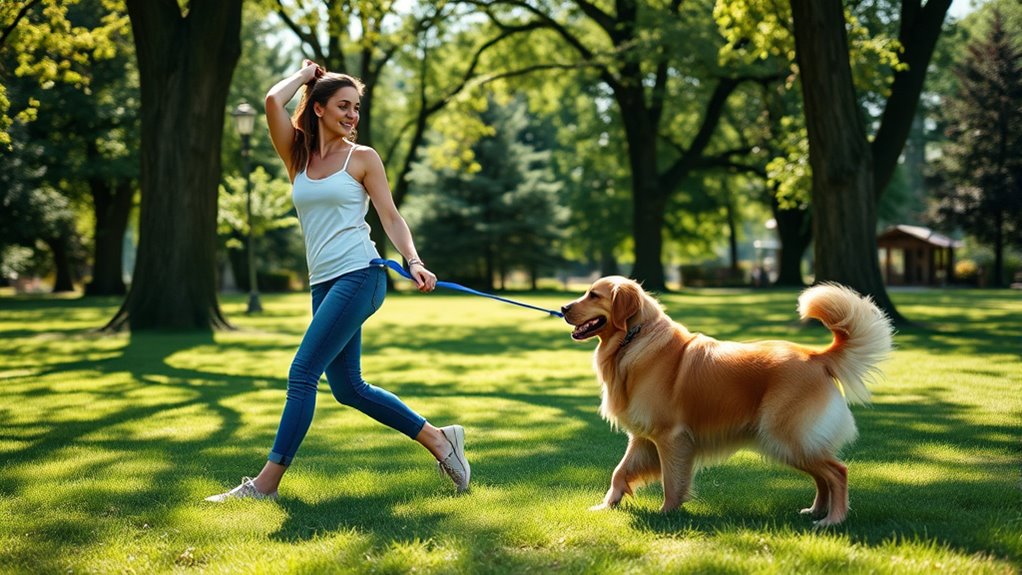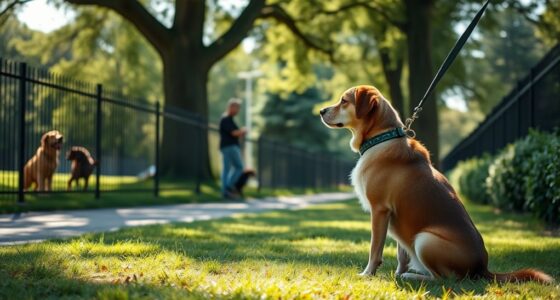To master loose-leash walking, start with proper equipment like a well-fitting harness and use clear commands such as “heel” or “let’s go.” Practice in quiet areas first, rewarding your dog when they walk calmly beside you. Stay patient and consistent, reinforcing good behavior with treats and praise. If your dog pulls or gets distracted, pause and redirect focus. Keep practicing and applying these techniques to enjoy more relaxed, enjoyable walks; more tips await as you continue.
Key Takeaways
- Use well-fitted, durable equipment like a harness and flat collar to ensure safety and clear communication.
- Establish consistent commands such as “heel” and “let’s go” with positive reinforcement.
- Practice in quiet areas first, gradually introducing distractions while rewarding calm behavior.
- Stop or loosen the leash when pulling to discourage tension and promote relaxed walking.
- Remain patient and consistent, rewarding calm walking and redirecting focus during challenges.
Choosing the Right Equipment

Selecting the right equipment is crucial for successful loose-leash walking. Your choice of harness selection and collar types directly impacts your dog’s comfort and control. A harness distributes pressure across the chest and shoulders, reducing strain on the neck, making it ideal for training and longer walks. Look for a well-fitted, sturdy harness that doesn’t restrict movement. Collar types vary from flat collars to martingales and choke chains; flat collars are suitable for everyday use, while martingales prevent slipping. Avoid choke chains or prong collars for training, as they can cause pain or injury. The key is selecting equipment that fits properly, feels comfortable, and allows you to communicate clearly without causing discomfort. Proper selection sets the foundation for effective, enjoyable loose-leash walking. Additionally, choosing appropriate gear can help maintain your dog’s motivation and reduce stress during walks. Ensuring your equipment meets safety standards is also vital to prevent injury and ensure peace of mind during outdoor activities. Using high-quality, durable materials can further enhance the longevity and safety of your gear, making every walk more enjoyable for both you and your dog.
Establishing Basic Commands and Cues
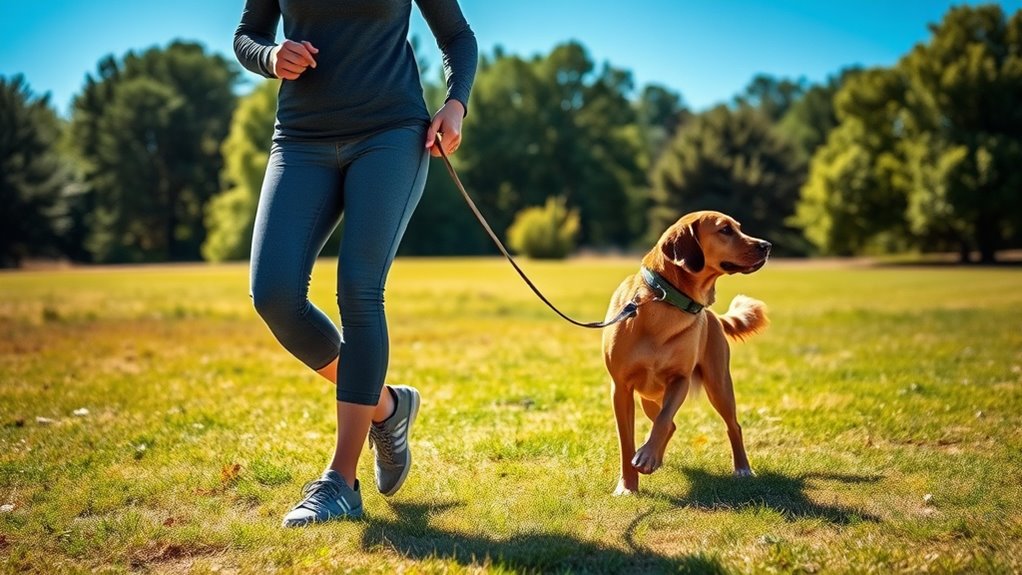
Before you can achieve loose-leash walking, establishing clear, consistent basic commands and cues is essential. These commands form the foundation of effective leash training and help your dog understand what you expect. Use positive reinforcement to reward your dog for responding correctly, encouraging good behavior. Consistency is key—always use the same words and gestures so your dog doesn’t get confused. For example, teach commands like “heel,” “let’s go,” or “wait” with patience and praise. Here’s a simple table to guide your training:
| Command | Cue Type | Reward Method |
|---|---|---|
| Heel | Verbal + Gesture | Treat + Praise |
| Let’s go | Verbal | Praise + Pet |
| Wait | Verbal + Gesture | Treat + Calm Praise |
Building a solid command vocabulary makes leash training easier and more enjoyable. Additionally, understanding and applying positive reinforcement techniques can significantly enhance your training success. Remember that consistency in your cues helps your dog learn faster and reduces confusion during walks. Incorporating clear communication methods ensures your dog comprehends commands effectively, making training more efficient.
Teaching Your Dog to Walk Calmly on a Leash
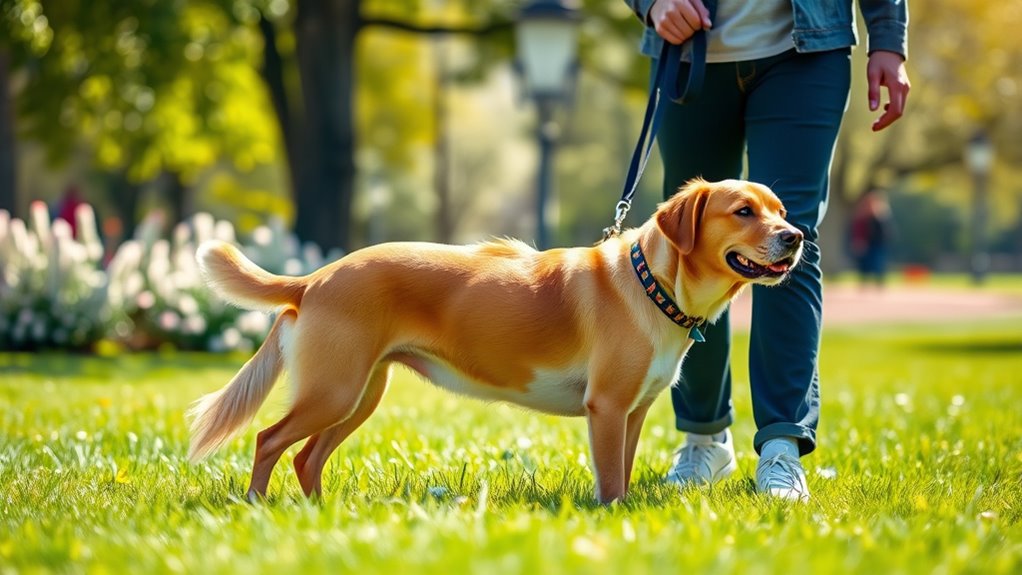
Once your dog understands basic commands like “heel” and “let’s go,” you can focus on teaching them to walk calmly on a leash. Start by practicing in a quiet area, gradually introducing distractions like other dogs or people to simulate dog park etiquette scenarios. Use leash pulling remedies such as stopping when your dog pulls and rewarding them when they walk beside you. Consistent timing helps your dog associate calm walking with positive reinforcement. Keep sessions short and positive, gradually increasing difficulty. If your dog pulls, gently correct with a firm “no” and redirect their attention to you. Patience is key—calm walking takes time to master, but with consistent practice, your dog will learn to stay relaxed and focused on your pace.
Practicing Consistent Reinforcement and Patience

Practicing consistent reinforcement and patience is essential because dogs learn best through regular, predictable cues. When you reward good behavior with positive reinforcement, your dog quickly understands what’s expected during walks. Keep your praise and treats steady, so your dog associates calm walking with rewards. Patience building is vital—some dogs take longer to adjust, and setbacks are normal. Stay calm and avoid frustration, reinforcing calm behavior each time it occurs. Consistency helps your dog develop trust and confidence in your guidance. Remember, progress might be gradual, but your persistent efforts will pay off. By sticking to a routine and practicing patience, you create a positive learning environment that encourages your dog to walk calmly and confidently on a loose leash. Incorporating training techniques such as clear cues and timing and consistency for reinforcement enhances your dog’s ability to learn and respond reliably. Understanding positive reinforcement strategies is also crucial to support your dog’s learning process effectively, including how to use appropriate rewards to motivate good behavior.
Troubleshooting Common Challenges During Walks
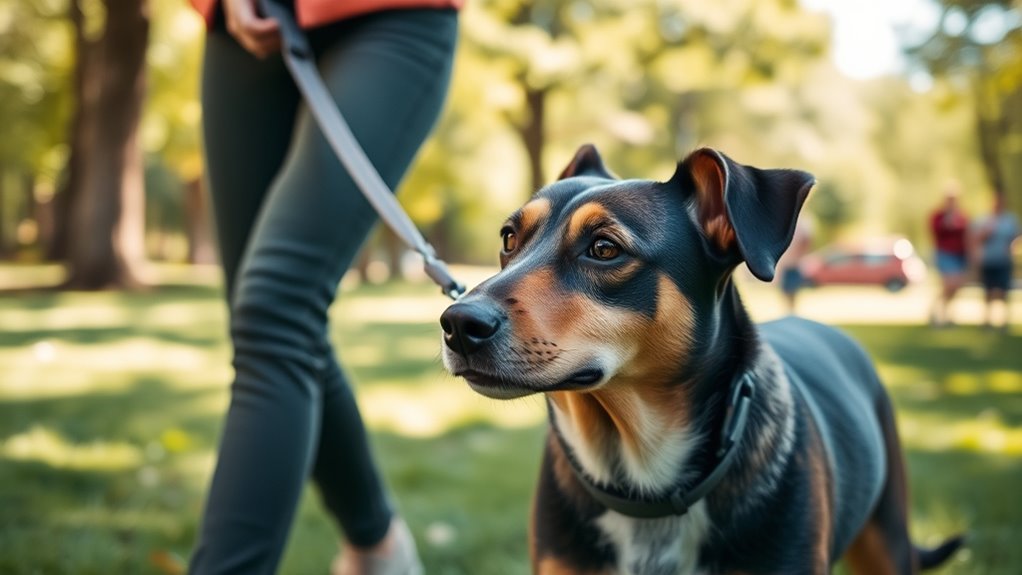
When your dog pulls or becomes distracted during walks, troubleshooting quickly can keep the walk on track. Focus on distraction management to redirect your dog’s attention, using treats or commands to regain focus. Monitor leash tension carefully; excessive tension indicates pulling, so loosen the leash to encourage relaxed walking. Here are three tips to handle common challenges:
- Identify distractions early—pause and redirect your dog’s focus before pulling escalates. Recognizing the importance of a strong father-daughter bond can motivate both of you to stay engaged and attentive during walks. Incorporating distraction training techniques can further improve your dog’s focus in busy environments. Being aware of distraction triggers allows you to anticipate and address potential issues proactively.
- Adjust leash tension—maintain a slack leash to promote comfort and control.
- Use consistent cues—reinforce commands to help your dog understand desired behavior amid distractions. Incorporating mental stimulation techniques can also help reduce your dog’s tendency to become distracted during walks.
Frequently Asked Questions
How Long Does It Typically Take to See Progress With Loose-Leash Walking?
Progress with loose-leash walking varies based on your training consistency and leash patience. Usually, you might see initial improvements within a few days to weeks, but it often takes several weeks or months for your dog to become reliably loose-leash. Stay patient and consistent, practicing daily. Remember, every dog learns at a different pace, so celebrate small wins and keep your training positive and steady.
Can These Techniques Work With All Dog Breeds and Sizes?
Think of loose-leash walking techniques as a universal recipe; some ingredients need tweaks for different breeds. You’ll find that breed adaptability and size considerations matter—small dogs may respond faster, while larger breeds require patience and different cues. I once trained a stubborn bulldog and a lively terrier using the same methods, adapting as needed. With consistency, these techniques can work across all breeds and sizes, though adjustments help guarantee success.
What Are Some Signs My Dog Is Becoming Distracted or Overstimulated?
When your dog becomes distracted or overstimulated, you’ll notice changes in body language like raised hackles, wide eyes, or a stiff posture. Environmental cues, such as loud noises or moving animals, can trigger this as well. You might see your dog trying to pull away, sniffing excessively, or becoming hyper-focused. Recognizing these signs early helps you respond calmly, redirect their attention, and maintain a relaxed, controlled walk.
How Do I Handle Leash Reactivity During Walks?
Did you know that leash reactivity affects about 50% of dog owners? To handle this, use calming signals like yawning or turning away to defuse tension. Incorporate distraction techniques such as treats or toys to redirect your dog’s focus. Stay calm and consistent, gradually exposing your dog to triggers at a distance, rewarding calm behavior. Over time, this approach helps your dog feel more secure and less reactive during walks.
Are There Specific Training Sessions Recommended for Puppies Versus Adult Dogs?
For your puppy, focus on socialization sessions to build confidence and reduce reactivity, while keeping training sessions short and fun. For adult dogs, emphasize consistency and reinforcement during training, addressing specific behaviors like leash reactivity. Tailor your approach to their age, using positive reinforcement and patience. Both should have regular, structured sessions that promote good leash manners, ensuring they feel safe and confident during walks.
Conclusion
Remember, mastering loose-leash walking is like guiding a ship through calm waters—you set the course with patience and consistent effort. As you build trust and understanding, your walks become smoother, echoing the harmony of a well-conducted orchestra. Stay committed, adapt to your dog’s needs, and enjoy the journey. With time, you’ll both navigate the streets with grace, turning each stroll into a shared adventure that’s as effortless as poetry in motion.

